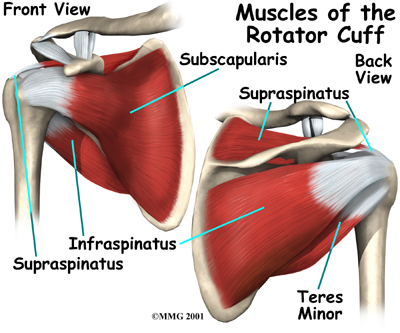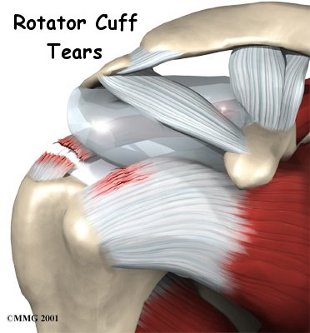Multi-Tendon Chronic Model
Rotator cuff tears are a common source of pain and disability. The majority of cases presented clinically are chronic tears which are often associated with poor repair rates. A previous study in the rat attempted to create a chronic injury with a single supraspinatus detachment without repair [1]. Unfortunately, the injury in the detached supraspinatus tendon recovered by 16 weeks. Another model has recently been developed in which multiple tendons are detached in a single surgery [2], and therefore, the objective of this study was to investigate whether a combined supraspinatus and infraspinatus detachment could result in a chronic injury in the supraspinatus tendon. Our primary hypothesis was that after such a two tendon detachment, the detached supraspinatus tendon would have decreased tensile mechanical properties, detrimental histologic changes and and decreased tissue organization compared to control, even at long time points.
 Results have shown continued detrimental alterations in the biomechanical, histological and organizational properties of the supraspinatus tendon even at a 16 week time point. An increase in tendon area and percent relaxation implies the increased production of poor quality matrix most likely in response to a decreased loading environment. In addition, an increase in percent relaxation is associated with increased water content and altered biochemical composition which likely occurs in an injury. These findings support the potential for a new chronic supraspinatus tendon injury model. Future work will explore the viscoelastic mechanical changes of this injured tendon as well as the response to repair.
Results have shown continued detrimental alterations in the biomechanical, histological and organizational properties of the supraspinatus tendon even at a 16 week time point. An increase in tendon area and percent relaxation implies the increased production of poor quality matrix most likely in response to a decreased loading environment. In addition, an increase in percent relaxation is associated with increased water content and altered biochemical composition which likely occurs in an injury. These findings support the potential for a new chronic supraspinatus tendon injury model. Future work will explore the viscoelastic mechanical changes of this injured tendon as well as the response to repair.
 Additionally, we have recently expanded the Chronic Tear model to examine the effects of large, chronic tears on overall joint health. Specifically, we are examining the effects of chronic tears of both the supraspinatus and infraspinatus tendons on the properties of other tendons in the shoulder, joint kinematics, and glenoid and humeral head cartilage. This effect is being examined through mechanical testing of both the neighboring tendons and the cartilage, ratwalk analysis, histological analysis, and advanced imaging techniques.
Additionally, we have recently expanded the Chronic Tear model to examine the effects of large, chronic tears on overall joint health. Specifically, we are examining the effects of chronic tears of both the supraspinatus and infraspinatus tendons on the properties of other tendons in the shoulder, joint kinematics, and glenoid and humeral head cartilage. This effect is being examined through mechanical testing of both the neighboring tendons and the cartilage, ratwalk analysis, histological analysis, and advanced imaging techniques.
We are also using this model to assess the effects of restoration of the "force-couple" in the rat shoulder. The rotator cuff is believed to act through force couples, with the infraspinatus and subscapularis muscles representing a paired anterior to posterior balance. In the setting of a large, chronic tear like that described above, does restoring the A-P balance of the force couple by repairing the infraspinatus tendon restore or improve overall joint health? The effect of this repair is being compared using the same techniques described above.
In this way, our lab is integrating both the Joint Damage and Chronic Tear aspect of our previous work.
For more information see:
- Gimbel JA, Van Kleunen JP, Mehta S, Perry SM, Williams GR, Soslowsky LJ. Supraspinatus tendon organizational and mechanical properties in a chronic rotator cuff tear animal model. J Biomech 37:739-749, 2004.
- Perry SM, Getz CL, Soslowsky LJ. The Effect or Tear Size on the Mechanical Properties of the Remaining Intact Tendons in a Rat Rotator Cuff Model. Trans Orthop Res Soc 32:1163, 2007.
